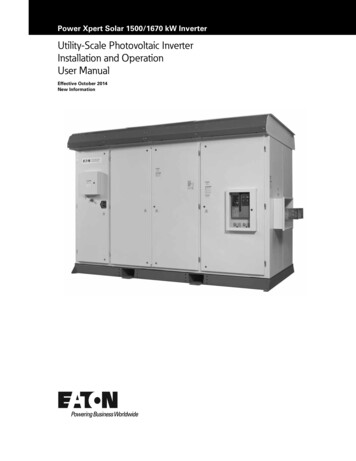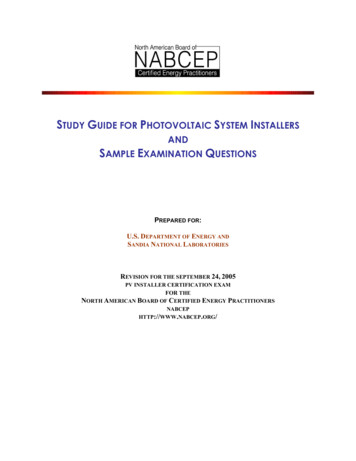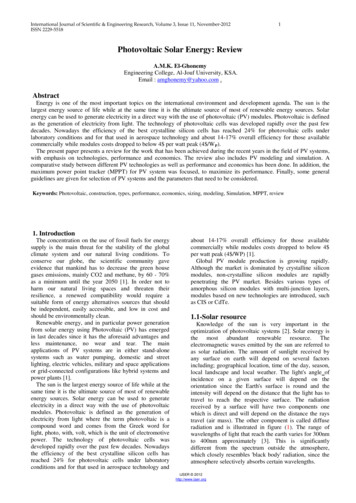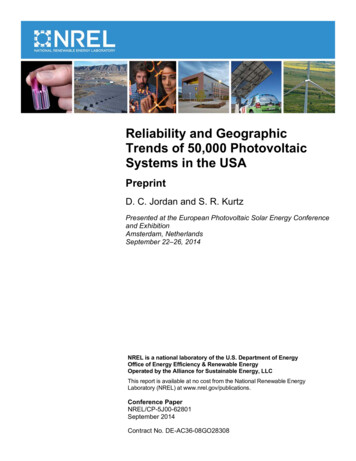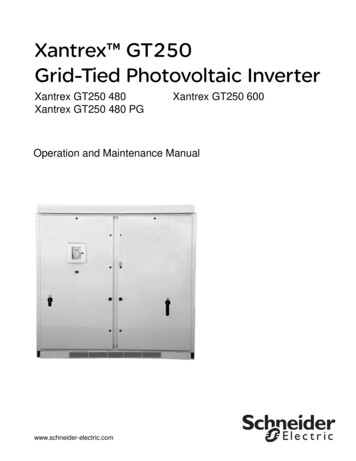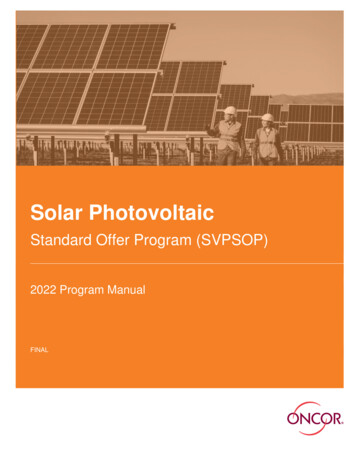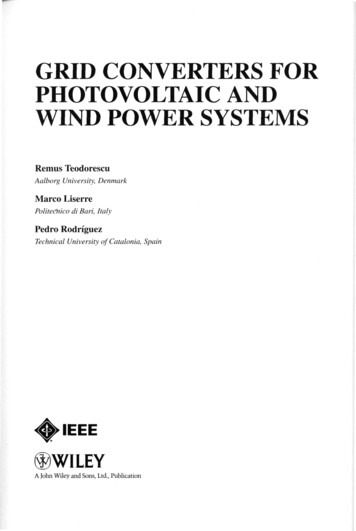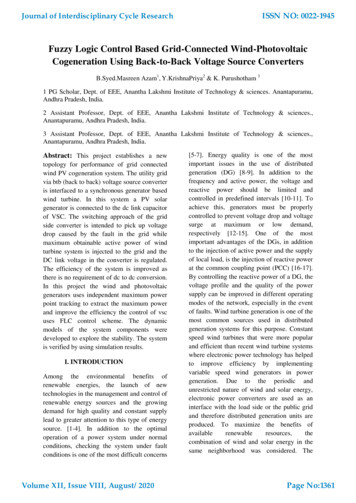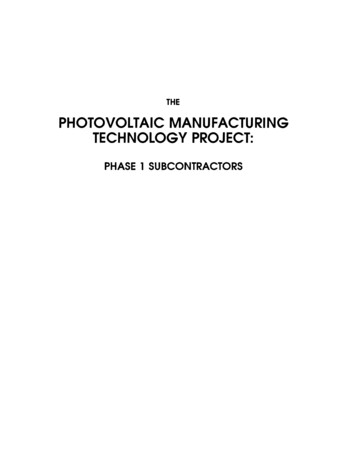
Transcription
THEPHOTOVOLTAIC MANUFACTURINGTECHNOLOGY PROJECT:PHASE 1 SUBCONTRACTORS
On September 16, 1991 the Solar Energy Institute was desig nated a national laboratory, and its name was changedto the National Renewable Energy Laboratory.NOTICEThis report was prepared as an account of work sponsored by an agency of the United States government. Neither the United States government norany agency thereof, nor any of their employees, makes any warranty, express or implied, or assumes any legal liability or responsibility for the accuracy,completeness, or usefulness of any information, apparatus, product, or process disclosed, or represents that its use would not infringe privately ownedrights. Reference herein to any specific commercial product, process, or service by trade name, trademark, manufacturer, or otherwise does notnecessarily constitute or imply its endorsement, recommendation, or favoring by the United States government or any agency thereof. The views andopinions of authors expressed herein do not necessarily state or reflect those of the United States government or any agency thereof.Printed in the United States of AmericaAvailable from:National Technical Information ServiceU.S. Department of Commerce5285 Port Royal RoadSpringfield, VA 22161Price: Microfiche A01Printed Copy A03Codes are used for pricing all publications. The code is determined by the number of pages in the publication. Information pertaining to the pricing codescan be found in the current issue of the following publications which are generally available in most libraries: Energy Research Abstracts (ERA);Government Reports Announcements and Index (GRA and I); Scientific and Technical Abstract Reports (STAR); and publication NTIS-PR-360 availablefrom NTIS at the above address.
THE PHOTOVOLTAIC MANUFACTURING TECHNOLOGY PROJECT:PHASE 1 SUBCONTRACTORSThe Phase 1 portion of the Photovoltaic Manufacturing Technology (PVMaT) Project, the problem identifi cation phase, was completed in mid- 1991 . This work involved competitive bidding that was open to anyU.S. firm with existing manufacturing capabilities, regardless of material or module design. In early 1 991,subcontracts were awarded to 22 of approximately 40 bidders. Each subcontract was funded at a levelof up to 50,000 and a duration of three months (see Table 1).The problems identified by the research in this phase of the program represent opportunities for industrialparticipants to improve their manufacturing processes, reduce manufacturing costs, increase productperformance, or develop a foundation for scaling up U.S.-based manufacturing plant capacities. Many ofthese opportunities have since been detailed in the approaches that these organizations suggested for Phase2 (the problem solution phase) research and development (R&D). It is not anticipated that any additionalPhase 1 solicitation will be issued because Phase 1 was intended to help the U.S. Department of Energy(DOE) characterize the status and needs of the U.S. photovoltaic (PV) industry and encourage the industryto examine and prioritize required manufacturing line improvements.Table1.PVMaT PhaseSubcontractor, LocationSpire Corporation, Bedford, MAAstropower Inc, Newark, DESolarex Corp., Rockville, MDSiemens Solar Industries, Camarillo, CAWestinghouse Electric Corp., Pittsburgh, PASilicon Energy Corp., Chatsworth, CAGlasstech S0lar Inc., Golden, COGlobal Photovoltaic Spec., Canoga Park, CAAlpha Solarco Inc., Cincinnati, OHPhoton Energy, Inc., El Paso, TXEnergy Conversion Devices, Troy, MIMobil Solar Energy Corp., Billerica, MAEntech Inc., Dallas, TexasBoeing Aerospace, Seattle, WASolar Kinetics, Inc., Dallas, TXChronar Corp., Lawrenceville, NJCrystal Systems Inc., Salem, MAIowa Thin Films Tech., Ames, lASolar Cells Inc., Toledo, OHKopin Corporation, Taunton, MASolar Engineering Appl, San Jose, CASpectrolab Inc., Sylmar, CA1SubcontractorsSubcontract #XC-1-10057-1XC-1-10057-2XC- 10057-7XC- 1-10057-8XC-1-10057-9XC-1-10057-10XC-1-10057- 1 1XC-1-10057-12XC- 1-10057-13XC- 1-10057-14XC- 1-10057-15XC- 1-10057-16XC-1-10057- 17XC-1-10057-18XC-1-10057-19XC- 1-10057-20XC-1-10057-2 1XC-1-10057-22Funding 49,843 50,000 49,974 46,181 49,992 49,602 49,913 47,800 48,380 49,500 50,000 50,000 49,940 49,862 48,290 49,080 50,000 47,827 38,034 50,000 50,000 35, 169Prin. Invest.S.J. HoganW.R. BottenbergJ. WohlgemathC. EberspacherR. RoseyM. StemS. BrownH. SombergE.C. SchmidtS.P. AlbrightM. IzuJ. KalejsM.J. O'NeillW.J. StanberyS.T. Saifee,J. MacneilF. SchmidD.P. GrimmerJ.L. BrownR.P. GaleN. KaminarD.R. Lillington
Phase 1 subcontracted research included five .subcontractors working on flat-plate crystalline silicontechnology, eleven working on flat-plate thin-film modules (one in thin-film crystalline silicon, six inamorphous silicon, and four in polycrystalline thin films), six working on concentrator systems, and twoworking on general equipment/production options. (Two of the participants each worked in two areas)Flat-Plate Crystalline Silicon ModulesCrystalline silicon is the most common semiconductor material used in commercial PV devices.PVMaT Phase 1 support, five companies detailed their problems in this technology.WithThis group ofcrystalline silicon research organizations includes Mobil Solar Energy Corp. of Billerica, Massachusetts;Crystal Systems Inc. of Salem, Massachusetts; Westinghouse Electric Corp. of Pittsburgh, Pennsylvania;Solarex Corp. of Rockville, Maryland; and Siemens Solar Industries of Camarillo, California.Mobil Solar Energy Corp. is a major manufacturer of crystalline-silicon modules using the edge-definedfilm-fed growth (EFG) method (shown inFigure 1).Mobil Solar is currently supplying a 180-kW(alternating current) array to Photovoltaics for Utility Scale Applications (PVUSA), a major demonstrationproject in California. Mobil Solar research under Phase 1 of PVMaT identified several problem areas thatFigure 1. Crystalline silicon grown by Mobil Solar Energy Corp., and the resulting solar cells
can be addressed to improve their process and reduce their silicon material usage by 50%. Among theseare reducing material usage by decreasing wafer thickness to an 8-mil (200-J.lll)l thickness, increasing lasercutting throughput, and improving the wafer mechanical quality.Crystal Systems Inc. is a manufacturer of crystalline-silicon ingots, bars, and wafers.research under Phase1Crystal Systemsof PVMaT identified several problem areas for improving their process. Amongthese are the optimization of the fixed abrasive slicing technique (FAST). This will allow for a reductionin slicing costs and an improvement in their material utilization, thus reducing wafer cost.Westinghouse Electric Corp. is the leading manufacturer of dendritic-web solar cells. Westinghouse isworking on reducing material and process costs through their dendritic web process.Westinghouseresearch under Phase 1 of PVMaT identified several problem areas for improving their process. Amongthese are increasing the growth rates, average crystal area, and productive furnace time; using stackeddiffusion; manufacturing larger cells and modules; increasing module efficiency by 1. 4% absolute usingsurface passivation, improved antireflective coatings, and cell texturization; and optimizing module designusing the bifacial conversion characteristics of dendritic-web solar cells.Solarex Corp. currently manufactures both polycrystalline silicon cells and thin-film, single-junction,amorphous silicon (a-Si) modules and is described in the next section.The fifth company working with crystalline silicon is Siemens Solar Industries. They are currently theworld's largest producer of PV systems with products including single-crystal silicon modules.Futureproducts are expected to include thin-film copper indium diselenide (CuinSe2) modules. Siemens researchunder Phase1of PVMaT identified several problem areas for improving their process. These includeimprovements in Czochralski crystalline-silicon growth, existing wafer sawing technology, and cellprocessing and module fabrication.Flat-Plate, Thin-Film ModulesModules made of thin-film materials have inherent cost advantages, including the use of less semiconduc tor material and integrated manufacturing for cells and modules. Prices for a-Si modules are comparableto those for crystalline silicon. Other promising thin-film technologies-such as CulnSe2, cadmium tellu ride (CdTe), thin-film silicon, and gallium arsenide (GaAs}-are rapidly approaching commercialization.Eleven U.S. companies have received PVMaT Phase1support to identify potential cost reductions forthin-film module manufacturing: one is working in thin-film crystalline silicon, six are concentrating ona-Si, and four have focused on polycrystalline thin films.AstroPower Inc. is the only manufacturer of thin-film crystalline-silicon solar cells. AstroPower researchunder Phase 1 of PVMaT identified several problem areas for improving their process.These includeimproving the production rate and quality of their proprietary silicon film, improving cell efficiency,reducing material cost, reducing labor cost through automation, and increasing production capacity.The six a-Si manufacturing and R&D organizations include Solarex Corp. of Rockville, Maryland;Glasstech Solar Inc. of Golden, Colorado; Iowa Thin Films Technologies Inc. of Ames, Iowa; EnergyConversion Devices (ECD) of Troy, Michigan; Silicon Energy Corp. of Chatsworth, California; andChronar Corp. of Lawrenceville, New Jersey. Glasstech Solar Inc. and Chronar Corp. have now closedtheir manufacturing facilities and are no longer functional.completeness.Their interests are summarized here for
Solarex Cmp. presently manufactures both polycrystalline silicon cells and thin-film, single-junction, a-Simodules. Solarex research under Phase 1 of PVMaT identified several problem areas for improving theira-Si manufacturing process.Among these are improving module efficiency (from the present 5% forsingle-junction modules) by introducing multijunction devices into the module assembly line, usingmaterials more efficiently via increased process yield, reducing labor content via automation, and reducingmaterial costs, particularly those of framing.Glasstech Solar Inc. was a manufacturer of single-junction a-Si modules.Glasstech used a proprietaryglass-in/panel-out concept for in-line processing of 40 em x 120 em a-Si modules.Glasstech researchunder Phase 1 of PVMaT identified several problem areas for improving their process. Among these arethe incorporation of a vertical, double-sided reactor; enhanced electrode and gas flow designs; improvedback contacts and tin-oxide layers; and improved module designs.Iowa Thin Film Technologies produces monolithic a-Si modules on a continuous polymer substrate usingautomated processing (shown inFigure 2).Iowa Thin Film research under Phase 1 of PVMaT identifiedseveral problem areas for improving their process. Among these are developing a roll-to-roll depositionFigure 2. Flexible, amorphous silicon module produced by Energy Conversion Devices
Figure 3. Utility Power Group's manufacturing linecapability for the a-Si and ZnO layers, developing screen-printable etching steps for the top conductingcontact layer, and reducing the cost of the substrate material.ECD manufactures continuous, roll-to-roll, tandem-junction, a-Si alloy devices. The roll-to-roll processproduces a complete solar cell structure on flexible stainless-steel webs 1000 feet long and 14 inches wide.ECD research under Phase 1 of PVMaT identified several problem areas for improving their process.Among these are incorporating lower-band-gap material to improve conversion efficiencies and stability,incorporating proprietary microwave plasma chemical vapor deposition manufacturing technology for high production throughput and higher gas utilization, and reducing the costs of materials and assembly laborthrough new product design and automation.Silicon Energy Corp. manufactures multiple-junction thin-film a-Si modules and is doing business as theUtility Power Group. The company has a 300 kW/yr production facility dedicated to internal R&Dactivities and various DOE PV projects. Utility Power Group's research under Phase 1 of PVMaTidentified several problem areas for improving their process. Among these are optimizing the automationof their manufacturing line (shown in Figure 3), improving and reducing the material required forencapsulation, and introducing real-time processing and quality control to their production line.
The sixth company working with a-Si is Chronar Corp., a manufacturer of thin-film a-Si devices. Chronarresearch under Phase 1 of PVMaT identified several problem areas for improving their process. Amongthese is the implementation of automated manufacturing to achieve large cost reductions.Four organizations have focused on polycrystalline thin films. This group of research organizationsincludes Siemens Solar Industries of Camarillo, California; Boeing Aerospace and Electronics of Seattle,Washington; Photon Energy Inc. of El Paso, Texas; and Solar Cells Inc. of Toledo, Ohio.Siemens Solar Industries, as previously stated, is currently the world's largest producer of PV productsbased on crystalline silicon. Siemens also has a major research activity in thin film CulnSe2 modules, forwhich they have a planned production of 20 kW in deliverable modules under the PVUSA project.Siemens research under Phase 1 of PVMaT identified several problem areas for improving their process.Among these are improving the efficiency of materials usage increasing yield and CulnSe2 moduleefficiency through automation.Boeing supplies thin-film solar cell manufacturing systems and conducts research on the development andscaleup of processing for CulnGaSe2 modules. Boeing research under Phase 1 of PVMaT identifiedseveral problem areas for improving their process. These include uniform large-scale evaporation sourcesfor the constituent elements Cu, In, Ga, and Se; a high-yield process for depositing ultra-thin cadmiumzinc sulfide (CdZnS) conformal coatings onto CulnGaSe2 films for high-quality heterojunctions; andscaling up current aqueous deposition processes and novel low-temperature organometallic chemical vapordeposition techniques.Two companies are investigating improvements to CdTe technology. Photon Energy manufacturesCdTe/CdS cells and modules using low-cost, high-throughput, production-line scalable spray processes.Photon Energy is currently preparing for the production of 20 kW of 4-tf CdTe module deliverables underthe PVUSA project. Photon Energy research under Phase 1 of PVMaT identified several problem areasfor improving their process. These include reducing labor costs through process automation, improvingmodule efficiency, and reducing material usage through improved equipment designs.Fourth in the thin-film group and the second CdTe company is Solar Cells Inc., which is adevelopment/manufacturing company producing large-area, thin-film PV modules for utility generatingsystems. They are developing the technology for a high-throughput manufacturing line to produce 60 emx 120 em thin-film CdTe PV modules deposited by close-spaced sublimation. Solar Cells research underPhase 1 of PVMaT identified several problem areas for improving their process. These includeinvestigating problems associated with uniform deposition of large-area modules, developing equipmentfor very high throughput deposition, developing patterning techniques for large-area modules, anddeveloping cost-effective encapsulation techniques.ConcentratorsConcentrator modules use lenses to focus and intensify the sunlight falling on banks of small, highlyefficient cells. Thus, smaller cell areas are required in concentrating modules and cell material costs aresubstantially reduced. R&D issues include optimum cell packaging and assembly, concentrator optics, andlow-cost tracking arrays and support structures. Manufacturing cost reductions would occur primarilythrough automated assembly.
The six concentrator companies working in this area include Alpha Solarco Inc. of Cincinnati, Ohio; SolarEngineering Applications Corp. of San Jose, California; Kopin Corporation of Taunton, Massachusetts;Entech Inc. of Dallas, Texas; Spectrolab Inc. of Sylmar, California; and Solar Kinetics, Inc. of Dallas,Texas.Alpha Solarco Inc. manufactures high-concentration PV modules. They are currently installing a second generation system on the world's largest automated two-axis solar tracking structure to produce low-costelectric power for utilities. Alpha Solarco research under Phase 1 of PVMaT identified several problemareas for improving their process. These include developing and testing new manufacturing designs,methods, and materials for cell assembly and PV modules; designing a prototype automated PV cellassembly line; and developing production controls and training procedures for prototype lines.Solar Engineering Applications Corp. manufactures lOX concentrator systems using one-sun cells witha 14 MW/yr extruded lens manufacturing facility in place. Research under Phase 1 of PVMaT identifiedseveral problem areas for improving their process. These include investigating the problems associatedwith, and the potential of, adding module housing sides to lens extrusions; and significantly reducing laborcosts through process automation.Kopin Corporation manufactures high-efficiency thin-film GaAs concentrator cells with a 22 MW/yrprototype production capability currently in place. Kopin research under Phase 1 of PVMaT identifiedseveral problem areas for improving their process. These include designing a tandem cell structure forlOOOX concentrators, improving thin-film cell processing manufacturing, and integrating into their cellfabrication process either a chemical removal process called chemical epitaxial liftoff or the cleavage oflateral epitaxy for transfer (CLEFT') process.Entech Inc. manufactures concentrator modules. Entech is currently producing 3 ft x 10 ft modules usingone-sun cells with line-focus Fresnel lenses. Entech's research under Phase 1 of PVMaT identified severalproblem areas for improving their process. These include working with key vendors to improve theproducts they supply to Entech, and dramatically reducing labor costs and increasing yield by processautomation.Spectrolab Inc. is a leading supplier of GaAs and Si solar cells and panels to the PV industry. Spectrolabresearch under Phase 1 of PVMaT identified several problem areas for improving their process. Theseinclude optimizing two specific multijunction concentrator designs based on discrete GaAs and Ge cells,improving manufacturing yields, and developing larger, more efficient metal-organic chemical vapordeposition growth systems.The sixth company working on concentrator technology, Solar Kinetics, manufactures crystalline-siliconconcentrator systems with a 2 00-600 kW/yr capacity. Solar Kinetics research under Phase 1 of PVMaTidentified several problem areas for improving their process. These include designing and developingprototype tooling for demonstrating low-cost injection molding of point-focus Fresnel lenses, producingdetailed designs of a 1-MW plant, and producing a detailed plant design for 5-MW capacity for automatedmanufacturing of 100-W concentrating PV modules. ·Other Phase 1 ActivitiesTwo Phase 1 participants are targeting improvements to their commercial lines of manufacturingequipment. This diversified group includes Global Photovoltaic Specialists Inc. of Canoga Park,California; and Spire Corporation of Bedford, Massachusetts.
Global Photovoltaic Specialists Inc. is a PV technology company that provides the equipment and know how for integrated turnkey factories. They are presently investigating the installation of a fully automated,computer-integrated production line in the United States. Research under Phase 1 of PVMaT identifiedseveral problem areas for improving their process. These include improving the characteristics of thesemicrystalline cast wafers; introducing processes such as spray-on diffusion, dual antireflective coatings,and ink-jet metallization printing; and developing and integrating all of the requirements for fullautomation using computer integrated manufacturing.Spire Corporation is a major manufacturer of PV test and module production equipment. Spire currentlyhas small-scale production activities for high-efficiency silicon modules and conducts material researchin compound semiconductors and a-Si. Spire research under Phase 1 of PVMaT identified several problemareas for improving their process. These include developing module processing equipment that will handlethin ( 200 J.Im) crystalline-silicon wafers, increasing automation, increasing processing rates, andincreasing processing yields.
Produced byNational Renewable Energy Laboratory1617 Cole BoulevardGolden, Colorado 80401-3393A Division of Midwest Research Institu teOperated for the U.S. Department of Energyunder Contract No. DE-AC02-83CH10093NREL/MK.-411-4973DE2010597July 1992
Mobil Solar Energy Corp., Billerica, MA Entech Inc., Dallas, Texas Being Aerospace, Seattle, W A . working on general equipment/poduction options. (Two of the participants each woked in two areas) . Westinghouse Electric Corp. is the leading manufacturer of dendritic-web solar cells. Westinghouse is


